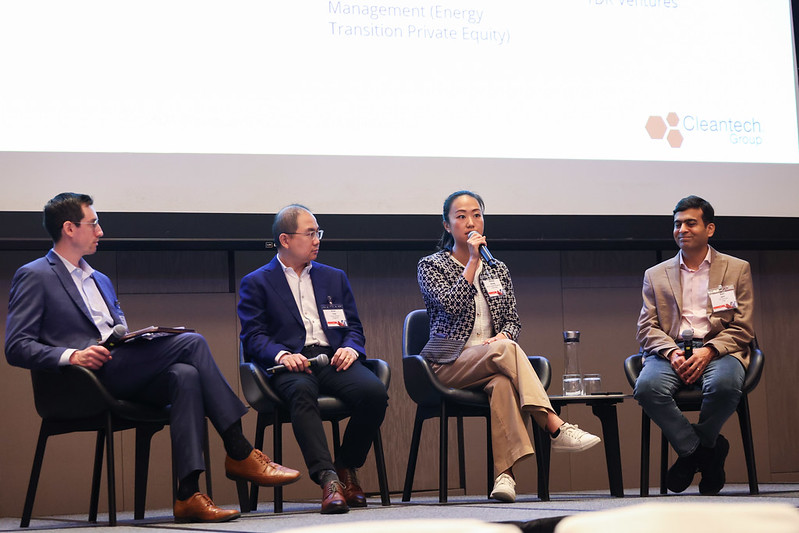At Cleantech Forum Asia, a pivotal conversation unfolded about what it means to build infrastructure for 2050—not just in terms of scale, but in the systems thinking required to meet unprecedented demands. The panel brought together voices from infrastructure investing, venture capital, and project development to explore where capital, innovation, and urgency converge. While the discussion was rooted in today’s realities, its tone was deeply future-focused, recognizing that infrastructure must evolve to meet needs not just emerging—but accelerating.

The New Anchors of Infrastructure: AI and Energy Demand
The panel began by acknowledging the elephant in the room: artificial intelligence. AI is no longer a niche domain—it’s a power-hungry driver of infrastructure that will define how we build data centers, upgrade grids, and even reshape global power markets. Historically modest in their energy draw, data centers are now ballooning into gigawatt-scale demands, no longer confined to a few remote outposts. Particularly in Asia, the buildout is constrained by geography: land, water, and power are all at a premium. This triad of scarcity forces a rethinking of location strategy and resource efficiency.
In North America, the dynamic is different—but equally intense. Developers are racing to deliver firm, dispatchable power—often turning to natural gas with carbon capture to meet hyperscaler expectations. The sheer size of proposed power projects—1 GW and up—is staggering. But the true bottleneck may not be generation; it’s interconnection. Navigating fragmented U.S. utility markets, with their labyrinthine queues and transmission hurdles, has become a core part of infrastructure strategy.
Meanwhile, venture capital is making bets not just at the megawatt level, but at the microchip. Investments in thermal management, silicon photonics, and power-efficient inferencing are targeting the foundational layers of compute. From grid transmission technologies to liquid immersion cooling, every slice of the stack is being scrutinized for efficiency gains.
Grid Resilience: From Megatrends to Microgrids
Whether in San Francisco or Singapore, data centers are driving a wholesale reevaluation of grid architecture. But this goes far beyond hyperscalers. In emerging markets like India, the growth in electricity demand spans both ends of the spectrum—from small EVs and distributed solar to massive industrial and compute loads. This duality—micro and macro—is creating pressure to evolve grid systems that were never designed for such variability.
A recurring theme was the need for “software-defined grids”—a new class of intelligent infrastructure that dynamically balances variable generation and consumption. In places with weak centralized grids, the opportunity to leapfrog into decentralized, AI-optimized systems is immense. Think smart meters, real-time demand shaping, and hybrid AC/DC modulation. The potential to rewire energy distribution is as much about bits as it is about electrons.
The Fragmentation of Compute and the Future of Sovereignty
If data centers were once centralized behemoths, they’re increasingly becoming fragmented and geopolitical. Data sovereignty, national security, and local AI development are reshaping where compute happens—and who controls it. As nations assert digital independence, we’re likely to see GPU-as-a-service models emerge closer to the edge, within national borders, in smaller modular clusters.
This shift has deep implications for telecom infrastructure as well. Subsea cables, long an invisible backbone of globalization, are now battlegrounds for influence. The panel discussed how geopolitical fragmentation is effectively splitting the internet’s plumbing—requiring parallel infrastructure for competing global blocs. The result? More investment, more redundancy, and more complexity.
Molecules on the Move: Hydrogen, Ammonia, and Maritime Opportunity
Beyond electrons, the panel turned its attention to molecules—particularly hydrogen and ammonia. Despite headline volatility, several panelists noted that demand signals are beginning to crystallize, particularly in industrial and maritime sectors. Investments are focusing on pragmatic approaches: methane pyrolysis producing carbon black and hydrogen, waste-to-hydrogen projects co-located with demand centers, and ammonia as a drop-in fuel for maritime decarbonization.
In markets like Japan, demand incentives are strong, even as timelines stretch into the 2030s. In India, the opportunity is more nascent but rich with potential—especially where modular, distributed hydrogen solutions can integrate with existing refinery and industrial use cases. The modularity of solutions like Verdagy’s electrolyzers enables smaller-scale deployments that match the fragmented energy landscape.
Maritime, often overlooked, was presented as a critical frontier. Specialized vessels for offshore wind farms, decommissioning oil rigs, and eventually transporting alternative fuels are sorely needed. Building new, fuel-flexible ships is a capital-intensive but necessary move if the marine sector is to decarbonize meaningfully. The takeaway? There’s a massive infrastructure gap at sea—and long-term capital has a critical role to play.
Designing Infrastructure for Machines, Not Just Humans
Perhaps the most provocative insight of the session was that future infrastructure will be built not primarily for human use, but for machines. The demands of AI, robotics, and digital services will drive infrastructure decisions to a greater extent than urban population growth. It’s a reversal of past planning assumptions—and a call for a new design philosophy.
In that world, infrastructure is not just a public utility or an economic enabler—it’s a strategic asset. One that must balance security, sustainability, scalability, and increasingly, sovereignty. From data centers and smart grids to maritime logistics and molecule movement, the story is clear: infrastructure innovation is no longer about catching up. It’s about anticipating what’s next.



